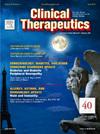基于韩国国民健康保险服务数据的免疫检查点抑制剂的实际使用模式。
IF 3.6
4区 医学
Q2 PHARMACOLOGY & PHARMACY
引用次数: 0
摘要
目的:本研究旨在全面了解韩国免疫检查点抑制剂(ICIs)的使用模式,包括其与传统抗癌疗法的联合使用。方法:我们使用韩国2017年至2022年的索赔数据调查了ICIs的使用情况。如果癌症患者接受了至少一剂量的ICIs(由索赔数据中的药物代码定义),则将其纳入研究。我们使用描述性统计来确定ICIs与其他抗癌疗法联合使用的模式,以及按年份和癌症类型划分的ICIs使用模式。结果:在研究期间,41208例患者接受了至少一剂ICIs。肺癌(66.6%)、尿路癌(11.3%)和肝/胆道癌(10.6%)是最常见的癌症类型。在2020年至2022年期间,用于治疗肝/胆道癌症的ICIs处方激增。在2017年至2022年期间,ici的使用从1155个增加到15034个,并且每年都在增加。自2020年以来,ICIs与其他抗癌疗法联合使用以及同时使用ICIs的情况急剧增加。启示:在韩国,使用ICIs的患者数量一直在稳步增加。随着ICIs适应症的监管批准的扩大,ICIs的适应症范围也在扩大。此外,近年来,ICIs与其他抗癌疗法的联合使用以及同时使用ICIs的情况有所增加,这反映了晚期癌症治疗选择的扩大。本文章由计算机程序翻译,如有差异,请以英文原文为准。
Real-World Utilization Patterns of Immune Checkpoint Inhibitors Based on the National Health Insurance Service Data in Korea
Purpose
This study was conducted to comprehensively understand the utilization patterns of immune checkpoint inhibitors (ICIs) in Korea, including their use in combination with traditional anticancer therapies.
Methods
We investigated the utilization of ICIs using claims data from Korea between 2017 and 2022. Patients with cancer were included in the study if they received at least one dose of ICIs, defined by drug codes in the claims data. We used descriptive statistics to identify patterns of ICIs use in combination with other anticancer therapies and ICIs use by year and cancer type.
Findings
During the study period, 41,208 patients received at least one dose of ICIs. Lung cancer (66.6%), urinary tract cancer (11.3%), and liver/biliary tract cancer (10.6%) were the most frequent cancer types. The prescription of ICIs particularly surged between 2020 and 2022 for liver/biliary tract cancer. Between 2017 and 2022, the use of ICIs increased from 1,155 to 15,034, with an increase every year. Since 2020, the use of ICIs in combination with other anticancer therapies and concurrent use of ICIs has increased sharply.
Implications
The number of patients utilizing ICIs in Korea has been steadily increasing. As regulatory approval of indications for ICIs has expanded, so has the range of indications for ICIs. In addition, the combination of ICIs with other anticancer therapies and the concurrent use of ICIs has increased in recent years, reflecting expanded treatment options for advanced cancers.
求助全文
通过发布文献求助,成功后即可免费获取论文全文。
去求助
来源期刊

Clinical therapeutics
医学-药学
CiteScore
6.00
自引率
3.10%
发文量
154
审稿时长
9 weeks
期刊介绍:
Clinical Therapeutics provides peer-reviewed, rapid publication of recent developments in drug and other therapies as well as in diagnostics, pharmacoeconomics, health policy, treatment outcomes, and innovations in drug and biologics research. In addition Clinical Therapeutics features updates on specific topics collated by expert Topic Editors. Clinical Therapeutics is read by a large international audience of scientists and clinicians in a variety of research, academic, and clinical practice settings. Articles are indexed by all major biomedical abstracting databases.
 求助内容:
求助内容: 应助结果提醒方式:
应助结果提醒方式:


